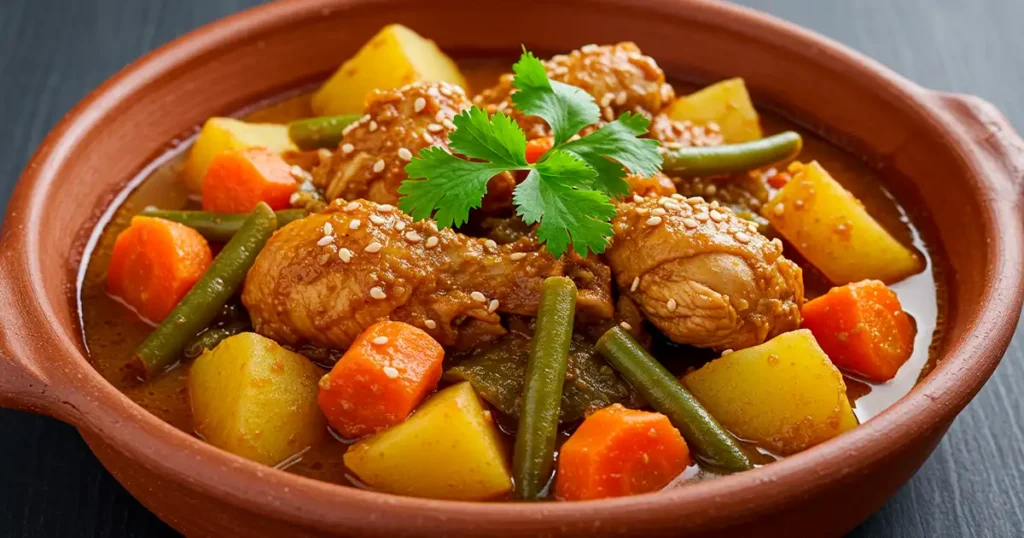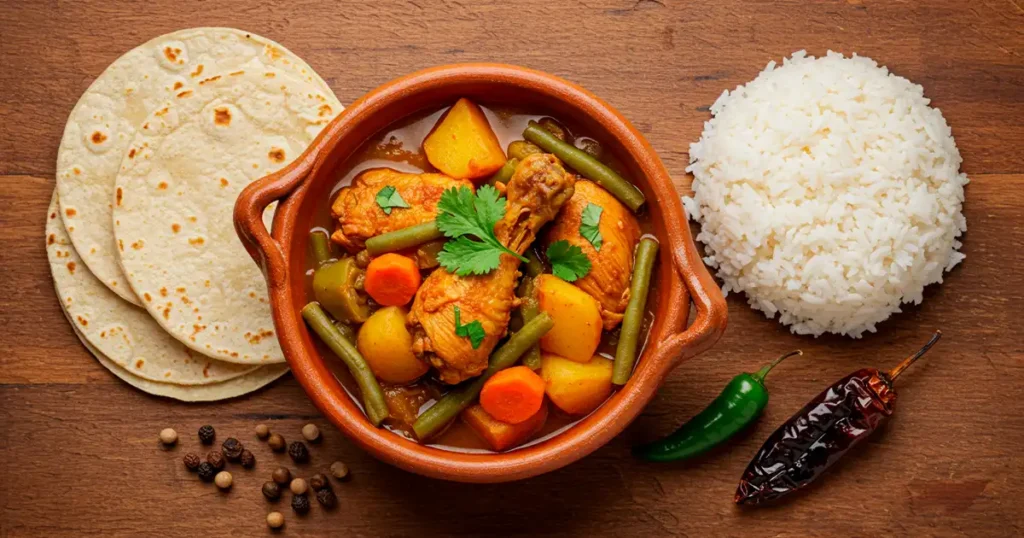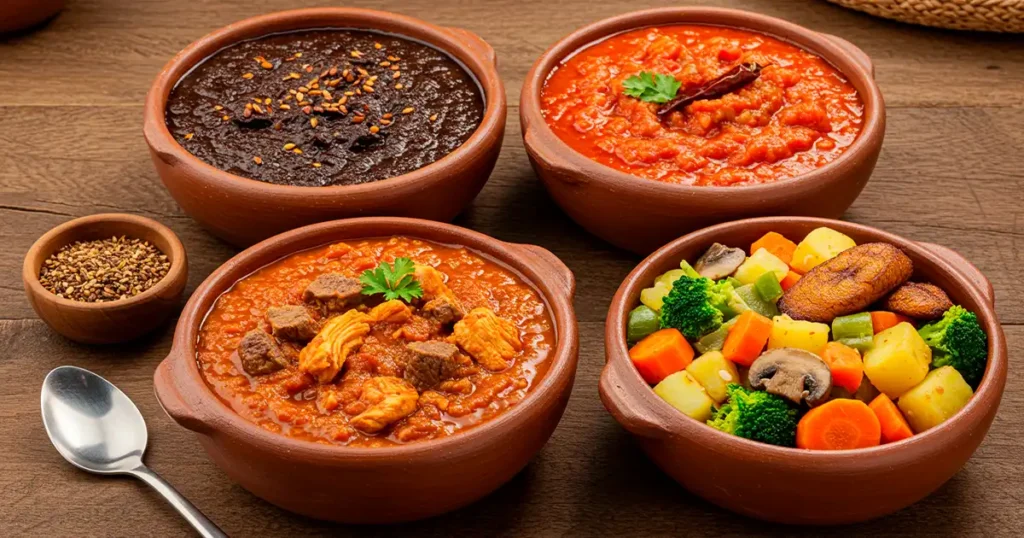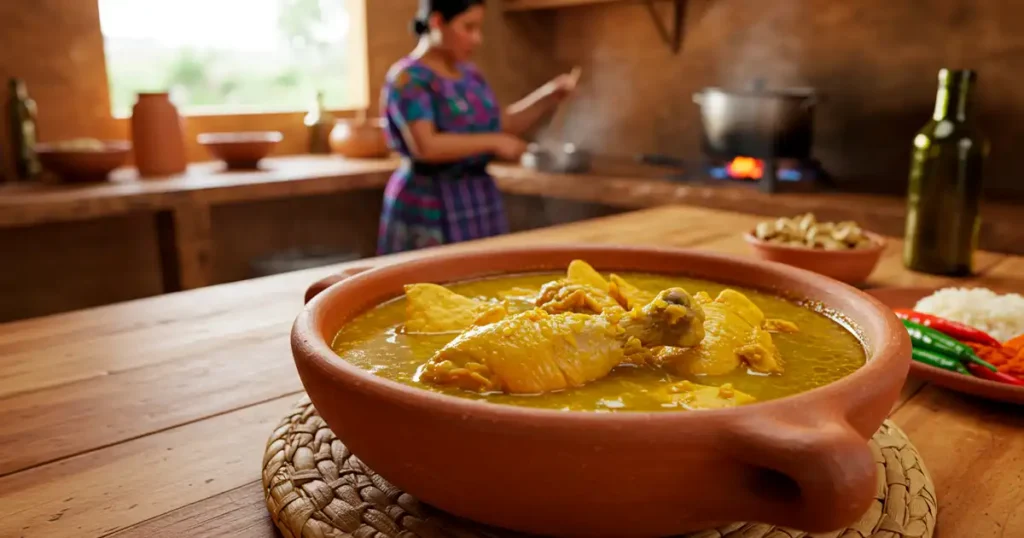Pepian de Pollo, a dish deeply woven into the fabric of Guatemalan culture, is more than just a meal; it’s a culinary heirloom passed down through generations. This hearty and aromatic chicken stew, often hailed as one of Guatemala’s national dishes, boasts a complex flavor profile born from a unique blend of Mayan and Spanish influences. Its rich, dark sauce, vibrant with roasted spices and vegetables, tells a story of ancient traditions and a nation’s gastronomic pride.
This article will take you on a journey to discover the magic of Pepian de Pollo. We’ll delve into its historical roots, explore the symphony of ingredients that create its distinctive taste, and guide you through the traditional cooking process. Whether you’re a seasoned food enthusiast or new to Guatemalan cuisine, prepare to be captivated by this iconic dish.
Ingredients
- 2 lbs chicken pieces (preferably thighs and drumsticks), cut into serving pieces
- 4-6 cups chicken broth (some reserved from cooking chicken, plus more as needed)
- 3 large Roma tomatoes
- 4 fresh tomatillos, husks removed
- 2-3 dried Guajillo chiles (Chile Guaque), deseeded
- 2-3 dried Pasa chiles (Chile Pasilla), deseeded
- 1 medium red bell pepper, roughly chopped
- 1 medium white onion, halved or quartered
- 5 cloves garlic
- 1 cup pumpkin seeds (pepitoria)
- 1 cup sesame seeds (ajonjolí)
- 1-2 day-old corn tortillas
- 1 cinnamon stick
- 3 black peppercorns
- 1/4 teaspoon ground cloves
- 1/4 teaspoon ground allspice
- 1 pinch dried oregano
- 1 medium chayote (güisquil), peeled and diced
- 2 medium potatoes, peeled and chunked
- 1/2 cup green beans, cut into 2-inch pieces
- 2 medium carrots, chopped
- 1/2 cup fresh cilantro, chopped (divided for sauce and garnish)
- Salt to taste
Instructions
A Glimpse into the History and Cultural Significance of Pepian
The origins of Pepian can be traced back to pre-Columbian times, with deep roots in the Mayan Kaqchikel indigenous communities, particularly in the department of Chimaltenango. Initially, this “recado” (a thick, savory sauce or stew) was an integral part of Mayan religious ceremonies and significant communal events. With the arrival of the Spanish, new ingredients like sesame seeds, cinnamon, and various meats were introduced, gradually shaping the Pepian we know today.
The enduring importance of Pepian in Guatemalan culture is undeniable. It’s a dish that frequently graces the tables during special occasions, family gatherings, weddings, and religious festivities. In 2007, Pepian was officially declared an Intangible Cultural Heritage of the Nation by the Guatemalan Ministry of Culture and Sports, a testament to its profound cultural value and its role in preserving the country’s culinary identity. This recognition underscores Pepian as a symbol of Guatemalan heritage, embodying centuries of history and the harmonious blend of its indigenous and colonial past.

The Essential Ingredients: A Symphony of Flavors and Textures
The heart of Pepian de Pollo lies in its intricate sauce, a carefully orchestrated blend of roasted and ground ingredients that create its signature depth and complexity. While recipes can vary from family to family and region to region, a core set of components defines this beloved stew.
Key Components of Pepian de Pollo:
- Chicken: Traditionally, the star protein is chicken, often cut into serving pieces and cooked until tender, its broth forming the base of the stew. However, Pepian can also be prepared with beef, pork, or a combination of meats.
- Roasted Seeds and Spices: This is where the magic truly happens.
- Pepitoria (Pumpkin Seeds): Toasted pumpkin seeds are fundamental, lending a nutty flavor and contributing to the sauce’s thickness.
- Ajonjolí (Sesame Seeds): Like pepitoria, toasted sesame seeds add another layer of nuttiness and aroma.
- Chiles: A variety of dried chiles are used, with Chile Guaque (Guajillo) and Chile Pasa (Pasilla) being the most common. These chiles are typically deseeded and toasted to awaken their smoky, mild to medium spicy notes. Some recipes may also include Chile Cobanero for a more pronounced heat.
- Cinnamon: A stick of cinnamon, toasted and ground, imparts a warm, aromatic undertone.
- Peppercorns and Cloves: These spices add a subtle complexity to the overall flavor profile.
- Roasted Vegetables:
- Tomatoes and Tomatillos: These provide acidity and sweetness, balancing the richness of the seeds and spices. Roasting them deepens their flavor.
- Onion and Garlic: Essential aromatics that form the flavor base of many Guatemalan dishes, including Pepian.
- Bell Pepper: Often a red bell pepper is included for sweetness and color.
- Thickening Agent: Traditionally, a cold, day-old corn tortilla is toasted and blended into the sauce, contributing to its characteristic thickness and a subtle corn flavor. Some variations might use bread.
- Vegetables for the Stew: Once the sauce is prepared, various vegetables are added to simmer with the chicken. Common additions include:
- Potatoes: Cut into chunks, they absorb the flavorful sauce beautifully.
- Carrots: Add sweetness and color.
- Güisquil (Chayote Squash): A mild-flavored squash that takes on the flavors of the stew.
- Green Beans: Provide a pleasant crunch and freshness.
- Cilantro: Fresh cilantro is often added towards the end of cooking or used as a garnish, lending a bright, herbaceous note.
The careful preparation and toasting of the seeds, chiles, and spices are crucial steps, as this process unlocks their essential oils and creates the deep, smoky, and nutty flavors that define Pepian.
Crafting Pepian de Pollo: The Traditional Preparation
Making Pepian de Pollo is a labor of love, a process that involves several steps, each contributing to the final, harmonious dish. While it may seem complex, the result is well worth the effort.

Step-by-Step Guide to Making Authentic Pepian:
- Cook the Chicken: The chicken pieces are typically simmered in water with salt, and sometimes aromatics like onion or garlic, until tender. The resulting chicken broth is reserved and forms an essential part of the sauce.
- Toast the Dry Ingredients: This is a critical stage. The pepitoria (pumpkin seeds), ajonjolí (sesame seeds), dried chiles (deseeded), cinnamon stick, and sometimes peppercorns and cloves are toasted on a comal (a flat griddle) or a dry skillet until fragrant and lightly browned. Care must be taken not to burn them, as this can impart a bitter taste. The toasted tortilla is also prepared during this step.
- Roast the Fresh Vegetables: Tomatoes, tomatillos, onion, garlic, and bell pepper are roasted, often on the same comal or under a broiler, until they are softened and slightly charred. This charring adds a smoky depth to the sauce.
- Blend the Sauce (Recado): The toasted dry ingredients and the roasted fresh vegetables are then blended together. Often, this is done in two parts:
- The toasted seeds, spices, and tortilla are ground first, sometimes with a little water or chicken broth to form a paste.
- The roasted tomatoes, tomatillos, onion, garlic, and bell pepper are blended separately, often with a bit of cilantro.
- Finally, these two mixtures are combined and blended again until smooth. The consistency should be that of a thick sauce. Some cooks strain the sauce to ensure a very smooth texture.
- Combine and Simmer: The blended sauce is added to a pot. If it’s too thick, some of the reserved chicken broth is stirred in. The cooked chicken pieces are then added to the sauce.
- Add Vegetables and Cook: The chopped potatoes, carrots, güisquil, and green beans are added to the pot with the chicken and sauce. The stew is brought to a simmer and cooked until the vegetables are tender and the flavors have melded together, typically for about 20-30 minutes. More chicken broth can be added if the stew becomes too thick.
- Final Touches and Serving: Fresh cilantro is often stirred in just before serving. Pepian de Pollo is traditionally served hot in a bowl, often accompanied by white rice and fresh corn tortillas to soak up every last bit of the delicious sauce. Some also enjoy it with a sprinkle of chopped cilantro on top.
It’s often said that Pepian tastes even better the next day, as the flavors continue to meld and deepen.

Variations of Pepian: A Dish with Many Faces
While Pepian de Pollo is perhaps the most widely recognized version, the beauty of this dish lies in its adaptability. Guatemalan cuisine celebrates regional differences and family traditions, leading to several delightful variations of Pepian.
- Pepian Negro (Black Pepian): This variation achieves its characteristic dark, almost black color from toasting the ingredients, particularly the chiles and seeds, more intensely, and sometimes by using specific types of chiles that lend a darker hue. The flavor profile is often deeper and smokier.
- Pepian Rojo (Red Pepian): This version tends to have a brighter red color, often achieved by using more tomatoes and specific chiles like Chile Guaque, and perhaps a lighter toasting of the ingredients.
- Pepian de Tres Carnes (Three-Meat Pepian): For a truly indulgent experience, some Pepian recipes call for a combination of chicken, beef, and pork. This version offers a richer, more complex meaty flavor to the stew.
- Vegetarian Pepian: While less traditional, it’s possible to create a vegetarian version of Pepian by omitting the meat and using a hearty combination of vegetables like potatoes, carrots, chayote, mushrooms, and plantains, with a rich vegetable broth as the base.

These variations highlight the versatility of Pepian, allowing cooks to adapt the dish to their preferences and available ingredients while still honoring its core identity as a rich, seed-based Guatemalan stew.
Experiencing Pepian de Pollo: Where to Find It
For those wishing to experience the authentic taste of Pepian de Pollo, Guatemala itself offers the most genuine encounters. It’s a staple in many traditional Guatemalan restaurants, particularly those specializing in “comida típica” (typical food). Markets, or “comedores” (small eateries) within them, often serve excellent, home-style Pepian at affordable prices, providing a truly local experience. Antigua Guatemala, with its vibrant culinary scene, is a particularly good place to find well-prepared Pepian.
Beyond restaurants, Pepian is a dish prepared with love in Guatemalan homes, especially for celebrations and family meals. If you have the opportunity to be invited to a Guatemalan home, tasting homemade Pepian can be an unforgettable culinary highlight.
For those outside Guatemala, finding authentic Pepian de Pollo might be more challenging but not impossible. Guatemalan restaurants in cities with significant Central American populations may feature it on their menus. Additionally, with the growing interest in global cuisines, recipes are readily available online for adventurous home cooks eager to recreate this flavorful stew in their own kitchens.

The Enduring Legacy of Pepian de Pollo
Pepian de Pollo is far more than just a popular Guatemalan dish; it is a vibrant expression of the nation’s history, culture, and culinary artistry. From its ancient Mayan origins to its evolution through Spanish colonial influences, Pepian has stood the test of time, remaining a cherished symbol of Guatemalan identity. The intricate process of toasting and grinding seeds and spices, combined with slow-simmered chicken and vegetables, results in a stew that is both complex and comforting, a true feast for the senses.
Whether enjoyed in a bustling Guatemalan market, a fine dining restaurant, or prepared with care in a home kitchen, Pepian de Pollo offers a delicious journey into the heart of Central American gastronomy. Its enduring popularity and its designation as a national cultural heritage ensure that this remarkable stew will continue to be savored by generations to come, a flavorful testament to Guatemala’s rich and diverse heritage.
